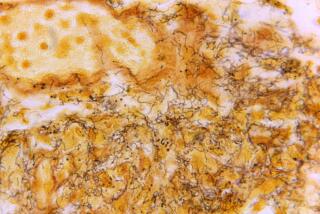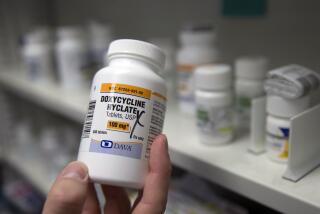AIDS Cases Up 29% for U.S. Women
WASHINGTON — AIDS cases among women in the United States have been steadily increasing, and the disease is expected to be among the five leading causes of death among women in 1991, federal health officials reported Thursday.
From 1988 to 1989, diagnosed cases of AIDS among women increased by 29%, compared to 18% in men, according to the Centers for Disease Control in Atlanta. And from November, 1989, through last month, women accounted for 11% of the 152,271 reported cases of AIDS in adults, the CDC said.
By the end of this year, reported AIDS cases among women in America will exceed 15,000, the agency said.
“Many women in the United States are unaware they are at risk for HIV infection and HIV-infected women often remain undiagnosed until the onset of AIDS, or until a perinatally infected child becomes ill,” the agency said in its Morbidity and Mortality Weekly Report.
In a related finding, the World Health Organization reported separately that the number of women infected with the human immunodeficiency virus “may well double as heterosexual transmission becomes the predominant mode of spread . . . in most parts of the world.”
WHO projected that a cumulative total of 600,000 women will have developed AIDS by 1992 and that the disease will kill at least 2 million women during the 1990s, most of them in sub-Saharan Africa.
“We must realize that women will bear an increasingly heavier burden as this pandemic progresses into the next century,” said Dr. Hiroshi Nakajima, director general of WHO.
While AIDS and HIV infection are spread predominantly through heterosexual sex in Africa and many other parts of the world, the disease in this country has struck hardest at homosexual and bisexual men and intravenous drug users.
As a result, at least during the early years of the epidemic, AIDS was not generally perceived as a disease of women in this country.
The number of women with AIDS in the United States has been growing in recent years, however, largely because of the widespread transmission of the HIV among drug users and their sexual partners.
“Even though the stereotypical AIDS patient is a white gay man, the face of the epidemic is changing,” said Dr. Harold Jaffe, deputy director for science at the HIV/AIDS division of the CDC. “Increasingly, AIDS is becoming a disease of black and Hispanic persons, of women and children.”
HIV infection has disproportionately affected minority women, reflecting to a large extent the intravenous drug connection, the CDC said. Although blacks and Latinos make up 19% of all U.S. women, they represent 72% of all U.S. women diagnosed with AIDS, the agency said.
“Many women with HIV infection are of lower socioeconomic status; therefore, prevention efforts, health care and social services--including those for drug treatment--rely on public resources,” the agency said.
AIDS cases among women have been reported in all 50 states but annual rates for states “vary markedly,” the agency said.
From November, 1989, through October, 1990, 4.3 cases per 100,000 women were reported in the United States, the agency said. Five areas--the District of Columbia, Florida, New Jersey, New York and Puerto Rico--reported more than 10 cases per 100,000 women. The report cited no specific data for California.
The CDC said that 85% of all AIDS cases in women occurred among those of childbearing age, and about 25% of these women were in their 20s at the time of diagnosis--meaning that many were probably infected as teen-agers.
By 1987, AIDS was the eighth leading cause of death in women 15 to 44 years, the CDC said. Based on current trends, the disease soon will be among the five leading killers of women, the agency said. The others are cancer, accidents, heart disease and homicide.
More to Read
Sign up for Essential California
The most important California stories and recommendations in your inbox every morning.
You may occasionally receive promotional content from the Los Angeles Times.










